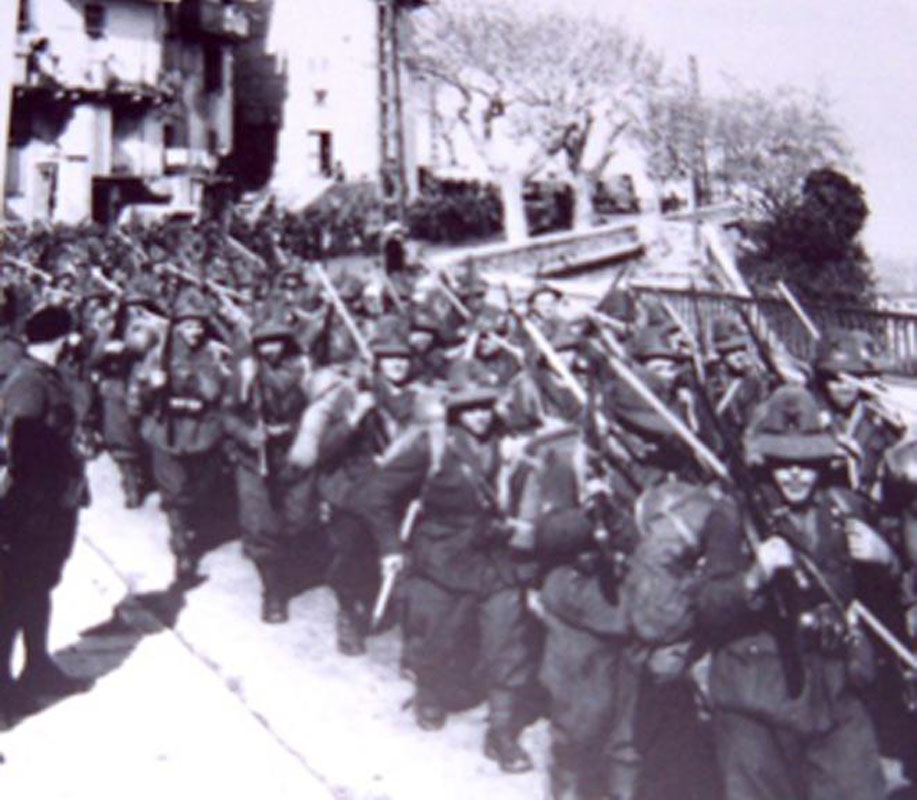Arrivée des troupes d'occupation italiennes le 11 novembre 1942
Légende :
Arrivée en Corse des troupes d'occupation italiennes le 11 novembre 1942 : elles traversent à Bastia le quartier Saint-Joseph pour gagner leur premier cantonnement au sud de la ville
Arrival in Corsica of occupying Italian troops on November 11th, 1942 where they then travelled through Bastia and the neighborhood of Saint-Joseph to reach their first station in the southern part of town
Genre : Image
Type : Photographie
Producteur : Musée A. Bandera d'Ajaccio
Source : © Collection Musée A. Bandera - Ajaccio Droits réservés
Détails techniques :
Photographie analogique en noir et blanc.
Date document : 11 novembre 1942
Lieu : France - Corse - Haute-Corse - Bastia
Contexte historique
L'occupant italien se dit, à son arrivée en Corse le 11 novembre 1942, "en opérations" de protection, une fiction que soutient l'Etat français. La représentation militaire allemande, qui se veut très discrète jusqu'à la chute de Mussolini en juillet 1943, laisse à l'Italie fasciste les pouvoirs de contrôle et de répression sur le territoire. Ils sont assurés par 80 000 hommes pour une population de quelque 200 000 habitants.
L'occupation militaire italienne en Corse a duré dix mois, à la suite d'un rapide débarquement fait par Bonifacio, et surtout par Bastia. L'île, que l'armistice de juin 1940 avait privé de moyens de défense, fut investie sans combats par 80 000 hommes de troupes, parmi lesquels des groupements de Chemises noires. Aucun canton ne resta inoccupé. Les Italiens disposaient d'armements lourds, de batteries côtières. Mais leur ravitaillement ne fut jamais assuré correctement et la région eut beaucoup à souffrir de leurs prélèvements.
Le 10 novembre 1942, sur un ordre personnel de Mussolini envoyé en Sardaigne et à Livourne, l'amiral Türr doit faire passer 20 000 hommes à Bastia et Bonifacio. Le débarquement italien (plan "Exigence C2") se fait le lendemain. Le général Mondino, commandant le VIIe corps d'armée, s'installe à Bastia au consulat d'Italie. Les troupes gagnent les autres villes. Elles comprennent deux divisions : Friuli et Cremona, réparties entre les régions de Bastia, de Corte et de Levie. Le 12 novembre, le gouvernement de Vichy envoie ses instructions sur les relations entre pouvoirs locaux et troupes d'opérations. Le préfet Balley les publie dès le lendemain.
Dans la période du 11 novembre 1942 au 19 janvier 1943, le VIIe corps d'armée italien se dit constitué de "troupes d'opérations". Du 19 janvier 1943 à l'armistice de septembre, il prend l'appellation de "troupes d'Occupation". Il est commandé par le général Carboni depuis le 29 décembre 1942. Le général Magli, qui lui succède en mars 1943, se trouve en Corse pendant la période la plus dure de la répression. Le service politique de l'armée, commandé successivement par le général de carabiniers Mazzerelli et le colonel Quercia, est un organe de surveillance et de répression dont l'activité croît en 1943.
En janvier 1943, l'OVRA (Organe de vigilance et de répression de l'antifascisme) est le service de contre-espionnage dont les pratiques ont fait l'analogue italien de la Gestapo allemande. Il est assisté pour les arrestations par les carabiniers royaux. Les incarcérations et interrogatoires ont lieu à Ajaccio, à la caserne Battesti, et à Bastia, à la caserne Marbeuf.
Upon their arrival on November 11th, 1942, Italian forces claimed to be performing “protection operations”, false pretenses that were supported by the French state. German military representation, hardly present in the region until the downfall of Mussolini in July 1943, allowed fascist Italy to maintain repressive power and control of the island. The Italians were guaranteed 80,000 troops for a population of 200,000.
Italian military occupation in Corsica lasted for 10 months, primarily in the region of Bastia, after a swift landing on the shores of Bonifacio. The island, deprived of its defense systems after the armistice of June 1940, was overtaken without a fight by 80,000 troops, including groups of Blackshirts. No area remained unoccupied. The Italian troops brought with them heavy artillery. Still, their food supplies were neither sufficient nor assured, and the region suffered greatly in their debt.
On the 10th of November 1942, under personal orders from Mussolini transmitted to Sardinia and Livorno, Admiral Türr sent 20,000 troops to Bastia and Bonifacio. The Italian landing (mission “Exigence C2”) was carried out the following day. General Mondino, commander of the 7th Corps, was placed in Bastia at the Italian consulate. The troops reached other cities. These troops were comprised of two divisions, Friuli and Cremona. They set off for the regions of Bastia, Corte, and Levie. On November 12th, the Vichy government sent instruction concerning the relations between local powers and occupying forces. Prefect Balley published them the very next day.
From November 11th, 1942 to January 19th, 1943, the 7th Corps of the Italian army claimed to be composed of “operational troops”. From January 19th, 1943 until armistice in September, they took the name “occupying troops”. They were commanded by General Carboni beginning on December 29th, 1942. General Magli, who succeeded him in March 1943, was present in Corsica during the most severe and repressive period of Occupation. The political sector of the army, commanded by General Mazzerelli and then Colonel Quercia, was a repressive surveillance entity that grew in size during 1943.
In January 1943, OVRA (Organization for Vigilance and Repression of Anti-Fascism) constituted the secret police whose practices were the Italian equivalent to those of the German Gestapo. They were assisted in arresting individuals by the royal Italian soldiers. These incarcerations and interrogations took place in Ajaccio, in the barracks of Battesti, and in Bastia, in the barracks of Marbeuf.
Sources :
CHAUBIN Hélène, Corse des années de guerre 1939-1945, Editions Tirésias-AERI, Paris, 2005
CHAUBIN Hélène, La Corse à l'épreuve de la guerre 1939-1943, Editions Vendémiaire, Paris, 2012.
Traduction : Sawnie Smith



 Voir le bloc-notes
()
Voir le bloc-notes
()